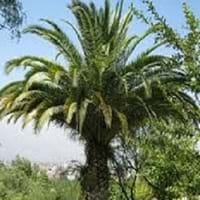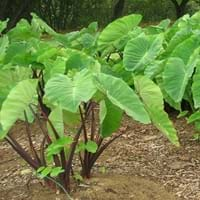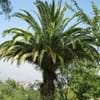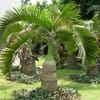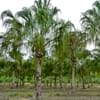Life Span
Perennial
Annual
Type
Palm or Cycad
Tender Perennial
Origin
Madagascar
Southeastern Asia
Types
Palm or Cycad
Eddoe taro, Dasheen taro
Number of Varieties
Not Available
Habitat
Rainforest
agricultural areas, Hillside, Warm and moist climatic conditions
USDA Hardiness Zone
10-15
10-11
Sunset Zone
H1, H2, 23, 24
H1, H2, 22, 23, 24
Habit
Arching/Fountain-shaped
Clump-Forming
Flower Color
Yellow
White, Green
Flower Color Modifier
Bicolor
Not Available
Fruit Color
Red, Orange
Red
Leaf Color in Spring
Green
Dark Green, Ivory
Leaf Color in Summer
Green
Dark Green, Ivory
Leaf Color in Fall
Green
Dark Green, Ivory
Leaf Color in Winter
Green, Dark Green
Dark Green, Ivory
Leaf Shape
Long Linear
V-Shaped
Plant Season
Spring, Summer, Fall, Winter
Spring, Summer, Fall, Winter
Sunlight
Full Sun, Partial Sun, Partial shade
Partial shade, Full Shade
Type of Soil
Loam, Sand
Loam, Sand
The pH of Soil
Acidic, Neutral
Acidic, Neutral
Soil Drainage
Well drained
Well drained
Bloom Time
Summer
Indeterminate
Tolerances
Not Available
Heat Tolerance, Humidity, Salt and Soil Compaction, Shallow soil
Where to Plant?
Container, Ground, Pot
Container
How to Plant?
Seedlings, Stem Planting
From Rhizomes
Plant Maintenance
Medium
Medium
Watering Requirements
Average Water Needs, Keep the ground moist but not water-logged, Never Over-water, Requires regular watering
Needs 2-3 times watering per week, Needs a lot of water initially
In Summer
Lots of watering
Lots of watering
In Spring
Moderate
Moderate
In Winter
Average Water
Average Water
Soil pH
Acidic, Neutral
Acidic, Neutral
Soil Type
Loam, Sand
Loam, Sand
Soil Drainage Capacity
Well drained
Well drained
Sun Exposure
Full Sun, Partial Sun, Partial shade
Partial shade, Full Shade
Pruning
Prune if you want to improve plant shape, Remove dead leaves
No pruning needed
Fertilizers
All-Purpose Liquid Fertilizer
All-Purpose Liquid Fertilizer, Less fertilizing
Pests and Diseases
Red blotch
Aphids, Rats, Snails
Plant Tolerance
Drought
Heat Tolerance, Salt and Soil Compaction, Shade areas
Flowers
Insignificant
Insignificant
Flower Petal Number
Single
Not Available
Foliage Texture
Bold
Bold
Foliage Sheen
Matte
Glossy
Attracts
Not Available
Aphids, Bugs, Not Available, Snails
Allergy
Not Available
Swelling in mouth, Throat itching
Aesthetic Uses
Beautification, Landscape Designing, Showy Purposes
Showy Purposes
Beauty Benefits
Not Available
Poison Ivy, Skin cleanser, Weightloss
Environmental Uses
Air purification
No fertilizer, pesticides, or herbicides needed, Prevent weeds
Medicinal Uses
Not Available
Aging, Laxative, Weight loss
Part of Plant Used
Leaves, Stem
Leaf Stalks, Leaves
Other Uses
Application in Furniture, Decoration Purposes, Showy Purposes
Used As Food, Used as Ornamental plant
Used As Indoor Plant
Yes
No
Used As Outdoor Plant
Yes
Yes
Garden Design
Feature Plant, Foundation, Mixed Border, Tropical
Container, Feature Plant, Groundcover, Houseplant, Mixed Border, Tropical
Botanical Name
DYPSIS cabadae
ALOCASIA micholitziana
Common Name
Cabada Palm
Elephant Ear, Taro
In Hindi
हथेली cabada
अरवी
In German
palm cabada
Colocasia (Pflanzengattung)
In French
Palm cabada
Colocasia
In Spanish
cabada palm
Colocasia
In Greek
παλάμη cabada
Colocasia
In Portuguese
palm Cabada
Colocasia
In Polish
palmowy Cabada
Kolokazja
In Latin
palm cabada
Colocasia
Phylum
Magnoliophyta
Magnoliophyta
Class
Liliopsida
Liliopsida
Clade
Not Available
Angiosperms, Monocots
Tribe
Not Available
Colocasiodeae
Subfamily
Not Available
Aroideae
Properties of Cabada Palm and Taro
Wondering what are the properties of Cabada Palm and Taro? We provide you with everything About Cabada Palm and Taro. Cabada Palm doesn't have thorns and Taro doesn't have thorns. Also Cabada Palm does not have fragrant flowers. Cabada Palm has allergic reactions like Not Available and Taro has allergic reactions like Not Available. Compare all the properties and characteristics of these two plants. Find out which of these plant can be used as indoor plant. If you are interested to decorate your house and garden, find out aesthetic uses, compare them and select the plant which will beautify your surrounding. Along with beautification, try comparing medicinal and edible uses of Cabada Palm and Taro and you can choose the plant having best and most benefits.
Season and Care of Cabada Palm and Taro
Season and care of Cabada Palm and Taro is important to know. While considering everything about Cabada Palm and Taro Care, growing season is an essential factor. Cabada Palm season is Spring, Summer, Fall and Winter and Taro season is Spring, Summer, Fall and Winter. The type of soil for Cabada Palm is Loam, Sand and for Taro is Loam, Sand while the PH of soil for Cabada Palm is Acidic, Neutral and for Taro is Acidic, Neutral.
Cabada Palm and Taro Physical Information
Cabada Palm and Taro physical information is very important for comparison. Cabada Palm height is 610.00 cm and width 460.00 cm whereas Taro height is 30.00 cm and width 30.00 cm. The color specification of Cabada Palm and Taro are as follows:
Cabada Palm flower color: Yellow
Cabada Palm leaf color: Green
Taro flower color: White and Green
- Taro leaf color: Dark Green and Ivory
Care of Cabada Palm and Taro
Care of Cabada Palm and Taro include pruning, fertilizers, watering etc. Cabada Palm pruning is done Prune if you want to improve plant shape and Remove dead leaves and Taro pruning is done No pruning needed. In summer Cabada Palm needs Lots of watering and in winter, it needs Average Water. Whereas, in summer Taro needs Lots of watering and in winter, it needs Average Water.
